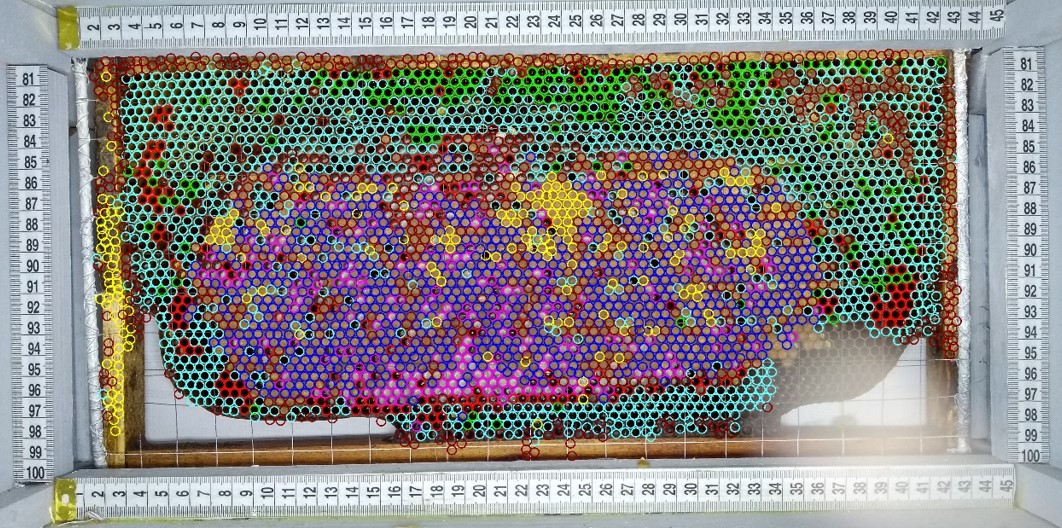Avaliação de algoritmos computacionais de reconhecimento digital de alvéolos em favos de abelhas africanizadas
DOI:
https://doi.org/10.52945/rac.v36i3.1735Palavras-chave:
Apis mellifera, Redes Neurais, Imagens digitais, DeepBeeResumo
As metodologias analógicas são bastante utilizadas para avaliar o estado geral, monitorar e estimar o desenvolvimento de colônias de abelhas Apis mellifera. Apesar de sua importância, tais métodos usados durante a etapa de campo são dificultosos, demorados e invasivos. Para verificar possibilidade de suprimir estas dificuldades, utilizou-se o software livre DeepBee©, de reconhecimento e classificação automática de alvéolos em imagens digitais. As imagens digitais foram obtidas com celular Androide utilizando-se uma câmara com iluminação artificial e sistema Bluetooth. As imagens foram obtidas em duas colmeias do tipo Langstroth, totalizando 28 imagens digitais. As colmeias estavam nos municípios de Videira e Caçador, em SC. O software DeepBee© detectou automaticamente sete classes de alvéolos: ovos, larvas, crias operculadas, pólen, néctar, mel e outros. Os algoritmos de processamento digital, topologia matemática e de reconhecimento de padrões por meio de redes neurais do DeepBee© permitiram a identificação do estado geral das colônias. Algumas falhas verificadas no reconhecimento de padrões sugerem necessidade de um novo treinamento da rede neural do software DeepBee© de forma a torná-lo uma ferramenta operacional para o acompanhamento do desenvolvimento das colônias de Apis mellifera africanizadas.
Métricas
Publication Facts
Reviewer profiles Indisp.
Author statements
- Academic society
- Epagri - Revista Agropecuária Catarinense
- Publisher
- Empresa de Pesquisa Agropecuária e Extensão Rural de Santa Catarina - Epagri
Referências
AL-TIKRITY, W.S.; HILLMANN, R.C.; BENTON, A.W. A new instrument for brood measurement in a honey bee colony. American Bee Journal, v.111, p.20-26, 1971.
ALVES, T.S.; PINTO, M. A.; VENTURA, P.; NEVES, C. J. ; BIRON D. G. ARNALDO, C.; ARNALDO Jr. C.; PAULA de L. F.; RODRIGUES, P. J. A Automatic detection and classification of honey bee comb cells using deep learning. Computers and Electronics in Agriculture, v.170, 2020. Doi: https://doi.org/10.1016/j.compag.2020.105244.
COLIN T.; BRUCE J.; MEIKLE W. G.; BARRON A. B. The development of honey bee colonies assessed using a new semi-automated brood counting method: CombCount. Journal Plos One, v.13, n.10. 2018. Doi: https://doi.org/10.1371/journal.pone.0205816.
CAPELA, N.; DUPONT, Y.L.; RORTAIS, A.; SARMENTO, A.; PAPANIKOLAOU, A.; TOPPING, C.J.; ARNOLD, G.; PINTO, M.A.; RODRIGUES, P.J.; MORE, S.J.; TOSI, S.; ALVES, T.S.; SOUSA, J.P. High accuracy monitoring of honey bee colony development by a quantitative method. Journal of Apicultural Research, v.62, n.4, 2022. Doi: https://doi.org/10.1080/00218839.2022.2098899.
DELAPLANE, K. S.; VAN DER STEEN,; J; GUZMAN, E. Standard methods for estimating strength parameters of Apis mellifera colonies. In: The COLOSS BEEBOOK, V.I: Standard methods for Apis mellifera research. Journal of Apicultural Research. v.52, n.1, 2013. Doi: https://doi.org/10.3896/IBRA.1.52.1.03.
DUBREUIL, V.; FANTE, K.P.; PLANCHON O.; SANT'ANNA NETO, J.L. Os tipos de climas anuais no Brasil: uma aplicação da classificação de Köppen de 1961 a 2015. Confins. Revue franco-brésilienne de géographie, v.37, 2018. Doi: https://doi.org/10.4000/confins.15738.
EMSEN, B. Medição semi-automática de áreas de criação tampadas de colônias de abelhas. Journal of Animal and Veterinary Advances, v. 5, n.12, p.1229-1232, 2006. Disponível em: https://medwelljournals.com/abstract/?doi=javaa.2006.1229.1232. Acesso em: 02 de maio de 2023.
LIEW, L.H.; LEE, B.Y.; CHAN, M. Cell detection for bee comb images using Circular Hough Transformation," 2010 In: International Conference on Science and Social Research (CSSR 2010), 1, 2010. Proceedings […]. Kuala Lumpur, Malaysia. p.191-195, 2010. Doi: https://doi.org/10.1109/CSSR.2010.5773764.
PAOLILLO, G.; PETRINI, A.; CASIRAGHI, E.; DE LORIO, M.G.; PAGNACCO, MINOZZI, G.; VALENTINI, G. Automated image analysis to assess hygienic behaviour of honeybees. Journal Plos One, v.17, n.1, 2022. Doi: https://
doi.org/10.1371/journal.pone.0263183.
SCHAFASCHEK, T.P.; HICKEL, E.R.; PEREIRA, H.L.; OLIVEIRA de, C.A.L.; TOLEDO de, V.A.A. Performance of Africanized honeybee colonies settled by queens selected for different traits. Acta Sci. Anim. Sci., v.38, n.1, 2016. Doi: https://doi.org/10.4025/actascianimsci.v38i1.26840.
SILVA da, D.F.; ARAUJO, I.G.; WELTER, J.H.; WAGNER, R.B.; MENEZES de, L.F.G.; ARBOITTE, M.Z. Desenvolvimento e produção de pólen em colmeias de Apis mellifera L. africanizadas mantidas em cultura de girassol. Agrarian, v.3, n.8, p.147–151, 2011. Disponível em: https://ojs.ufgd.edu.br/index.php/agrarian/article/view/792. Acesso em: 30 dezembro. 2022.
SILVA, R.; FREITAS, B.M. Produção e desenvolvimento de colônias de abelhas africanizadas (Apis mellifera l.) a partir de diferentes áreas e idades de cria. Cienc. Rural, Santa Maria. v.34, n.2, p.545-549, 2004. Doi: https://doi.org/10.1590/S0103-84782004000200032.
TAPIA-GONZÁLEZ, J.; LEÓN-MANTECÓN, T.; CONTRERAS-ESCAREÑO, F. M.; TAPIA-RIVERA, J.; GUZMÁN-NOVOA, E. Influencias climáticas regionales y cantidad de cría en el comportamiento higiénico de Apis mellifera. Abanico veterinario, v.11, p.1-16, 2021. Doi: https://doi.org/10.21929/abavet2021.20
VIEIRA, H.J.; SEZERINO, A.A.; SCHAFASCHEK, T.P.; ARAÚJO de, C.E.S. Câmara com iluminação artificial e sistema Bluetooth para aquisição de imagens digitais dos quadros do ninho de colônias de Apis mellifera. Agropecuária Catarinense, Florianópolis, v.35, n.3, 2022.
WSC-Regexpert. Photography for Honeybee Brood Trials. WSC Scientific GmbH. Heidelberg, Germany. 2016. Disponível em: http://wsc-regexperts.com/en/honeybees/photography-for-honeybee-brood-trials. Acesso em: 24 abril 2023.

Downloads
Publicado
Como Citar
Edição
Seção
Licença
Copyright (c) 2023 Hamilton Justino Vieira, Carlos Eduardo Salles de Araújo, André Amarildo Sezerino, Tânia Patrícia Schafaschek, Rafael Canan

Este trabalho está licenciado sob uma licença Creative Commons Attribution 4.0 International License.




